Setting Up a Jira REST Connection Manager
The REST Connection Manager is an SSIS connection manager that can be used to establish connections and facilitate data integration with REST based APIs and services such as Jira, among many more.
Integration for Jira is enabled by the following two components:
To add a new connection, right-click the Connection Manager area in your Visual Studio project, and choose "New Connection..." from the context menu. You will be prompted the "Add SSIS Connection Manager" window. Select the "REST (KingswaySoft)" item to add a new REST Connection Manager.
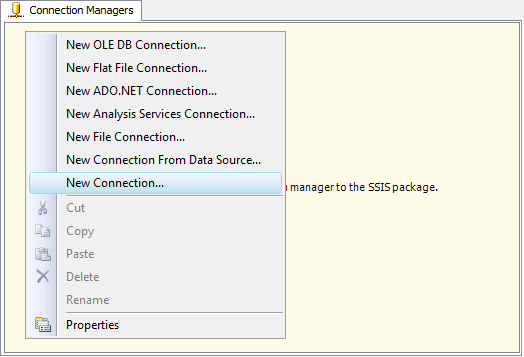
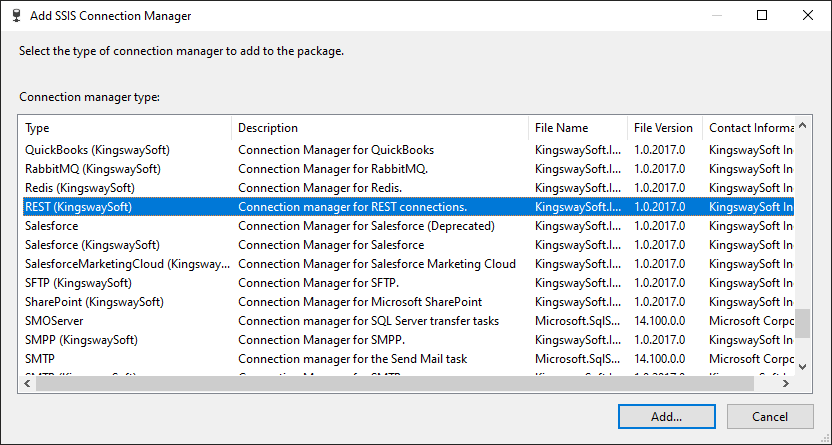
The REST Connection Manager contains 2 configuration pages:
- General
- Advanced Settings
General Page
The General page allows you to specify connection properties and login credentials for the Jira REST service:
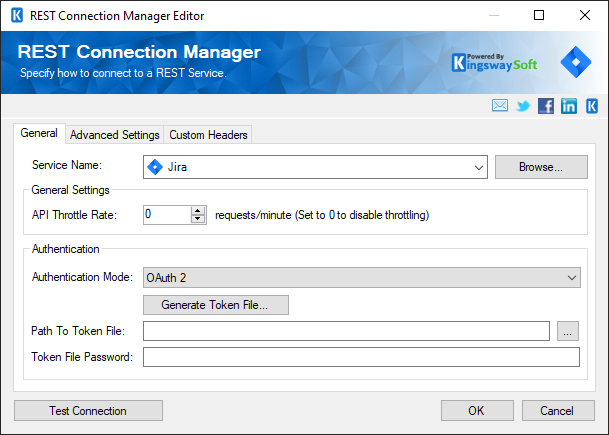
- Service Name
-
The REST service that will be connected to.
- General Settings
-
- API Throttle Rate
-
The API Throttling Rate will limit the number of requests that can be sent per minute.
- Authentication Mode
-
The Authentication Mode to be used in order to connect to your Jira instance. Available options are:
- API Token
- OAuth 2 (since v20.2)
- Basic (since v21.1)
- API Token
-
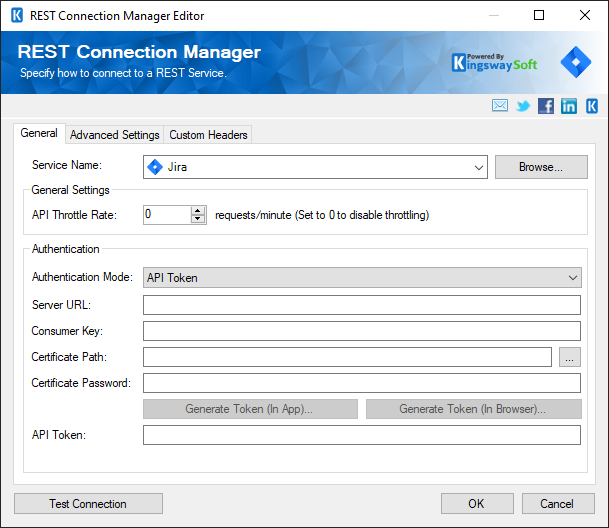
- Server URL
-
The URL of the Jira server that you want to connect to.
- Consumer Key
-
The Consumer Key to use when requesting a Jira Access Token. You can navigate to Application links in the Jira system to configure the client app to get the Consumer Key.
- Certificate Path
-
The Certificate Path specifies the location of the certificate that will be used.
- Certificate Password
-
The Password to the certificate file.
- Generate Token (In App)…
-
This button will open the In App authentication window through which you can authenticate to your Jira instance and retrieve the API Token.
- Generate Token (In Browser)…
-
This button will open your default browser where you can authenticate to your Jira instance. Once authenticated, you will be redirected to a URL, which you can copy and paste as your redirect URL.
- API Token
-
The API Token that is retrieved via authentication.
- Show Token
-
The masked API Token is shown.
- OAuth 2
-
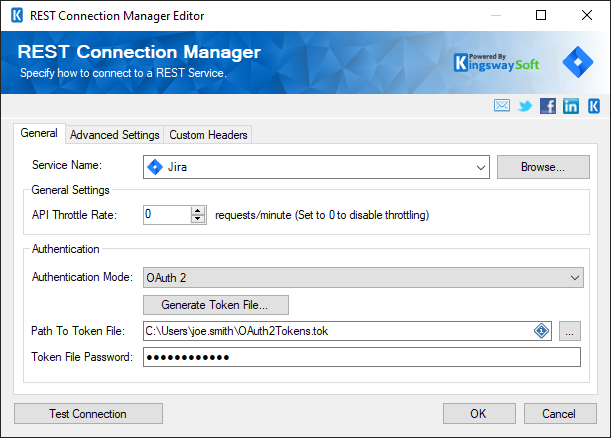
- Generate Token File
-
This button allows you to log in to the service endpoint and authorize your app to generate a token.
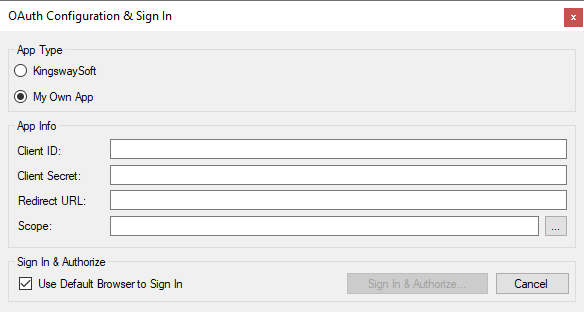
- App Type
-
- KingswaySoft
-
Selecting KingswaySoft App, the connection manager will use the client ID and secret that is provided by KingswaySoft for your convenience when setting up a connection. Please note that this should be used only for testing.
- My Own App
-
Selecting this option will allow you to use your own credentials.
- App Info
-
Here you can enter the Client ID, Client Secret and the Scope depending on the OAuth 2 setup at the API side. The Redirect URL will be the one that you had specified in the App settings.
- Sign In & Authorize
-
- Use Default Browser to Sign In
-
When this option is checked the Sign In & Authorize button will open your default web browser to complete the OAuth authentication. When this option is unchecked, the Sign In & Authorize button will complete the entire OAuth authentication process inside of the toolkit.
- Sign In & Authorize button
-
This button allows you to log in to the service endpoint and authorize your app to generate a token.
- Path To Token File
-
The path to the token file on the file system
- Token File Password
-
The password to the token file.
- Basic
-
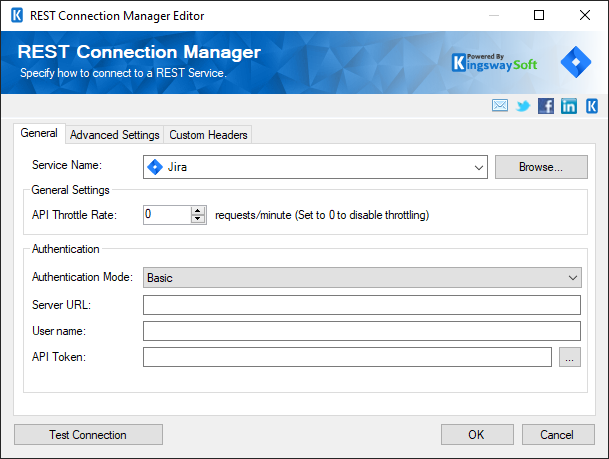
- Server URL
-
The URL of the Jira server that you want to connect to.
- User name
-
The Username to use when accessing Jira service.
- API Token
-
The API Token associated to the specified user when the accessing the Jira service.
- Personal Access Token
-

- Server URL
-
The URL of the Jira server that you want to connect to.
- Access Token
-
The Access Token to use to authenticate to Jira server.
- Test Connection
After all the connection information has been provided, click the "Test Connection" button to test if the user credentials entered can connect to the selected REST service.
Advanced Settings Page
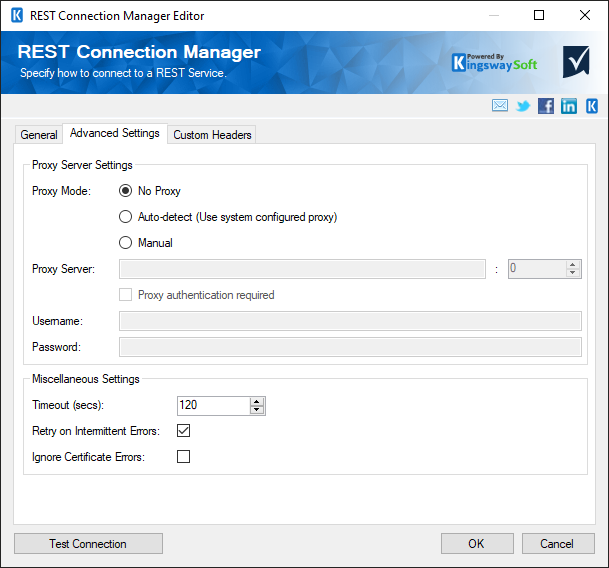
- Proxy Server Settings
-
- Proxy Mode
-
The Proxy Mode option allows you to specify how you want to configure the proxy server setting. There are three options available:
- No Proxy
- Auto-detect (Using system-configured proxy)
- Manual
- Proxy Server
-
Using the Proxy Server option allows you to specify the name of the proxy server for the connection.
- Port
-
The Port option allows you to specify the port number of the proxy server for the connection.
- Username (Proxy Server Authentication)
-
The Username option (under Proxy Server Authentication) allows you to specify the proxy user account.
- Password (Proxy Server Authentication)
-
The Password option (under Proxy Server Authentication) allows you to specify the proxy user's password.
Note: The Proxy Password is not included in the connection manager's ConnectionString property by default. This is by design for security reasons. However, you can include it in your ConnectionString if you want to parameterize your connection manager. The format would be ProxyPassword=myProxyPassword; (make sure you have a semicolon as the last character). It can be anywhere in the ConnectionString.
- Miscellaneous Settings
-
- Timeout (secs)
-
The number of seconds requests should wait before timing out.
-
- Retry on Intermittent Errors
-
The retry on intermittent errors option determines if requests will be retried when there is an error. If this option is checked requests will be retried up to 3 times.
- Ignore Certificate Errors
- This option can be used to ignore those SSL certificate errors when connecting to Jira servers.
Warning: Enabling the "Ignore Certificate Errors" option is generally NOT recommended, particularly for production instances. Unless there is a strong reason to believe the connection is secure - such as the network communication is only happening in an internal infrastructure, this option should be unchecked for best security.
Custom Headers Page
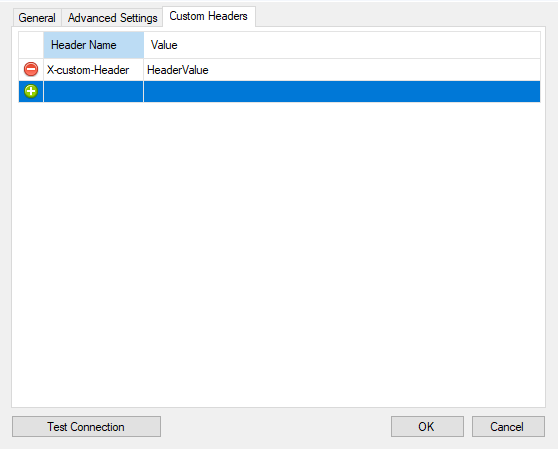
The Custom Headers page will allow you to set the Header Name and Header Value. You may select the green icon to add another row, and the red icon to remove an existing header you have configured.

